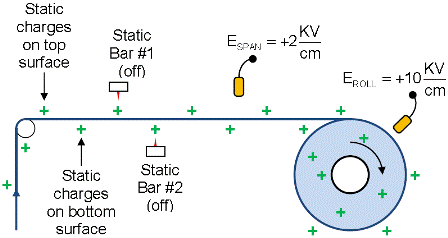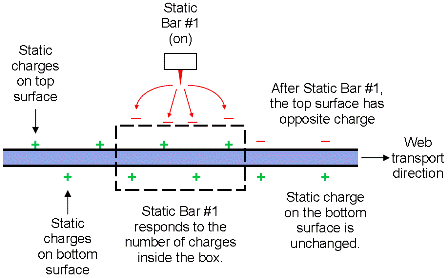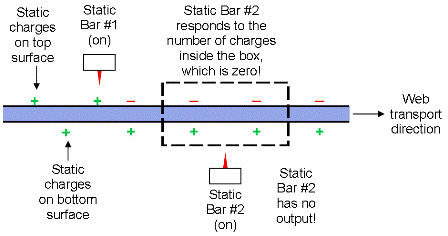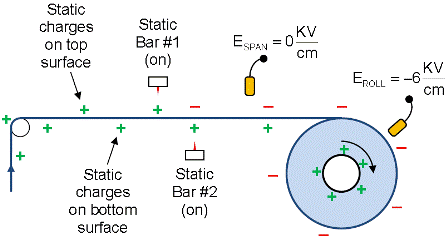2 Static Bars for Static on 2 Sides?
- Published: May 28, 2012, By Kelly Robinson

Figure 1: The web with positive static on both the top surface and on the bottom surface is being wound. Electrostatic fieldmeter reading ESPAN confirms the low level of positive static on the web. The electric field near the roll surface is highly positive. Static Bar #1 and Static Bar #2 are intended to neutralize the web prior to being wound.
When static can be on both sides of a web, can two static bars neutralize the charges on both sides? For example, the web being wound in Figure 1 has positive static charges on both the top and the bottom surfaces. The electrostatic fieldmeter reading ESPAN on the web span entering the winding roll confirms that the web has a low level of positive static. However, since all of this static is accumulated in the winding roll, electrostatic fieldmeter reading EROLL measured near the surface of the winding roll is highly positive.

Figure 2: The web enters from the left with positive static charges on both the top and bottom surfaces. Static Bar #1 responds to the four positive charges inside the box by generating four negative charges that deposit on the web surface facing the static bar. The results is that static charges on the web downstream of Static Bar #1 are balanced with two negative charges on the top surface and two positive charges on the bottom surface.
To see how the static bars operate, turn on the static bars one at a time. When Static Bar #1 is on in Figure 2, it responds to the 4 positive charges within the box by generating 4 negative charges. The four negative charges move quickly through the air and deposit on the web surface facing the static bar. Only the charges on the top surface facing the static bar are treated. The charges on the bottom surface are unchanged. The result is that the static charges downstream of Static Bar #1 are balanced with negative static charges from the static bar on the top surface and an equal number of positive charges on the bottom surface that are unchanged by the static bar.

Figure 3: The web exits Static Bar #1 with negative static charges on the top surface and an equal number of positive charges on the bottom surface. Since the net charge inside the box is zero, the output of Static Bar #2 is zero.
Now in Figure 3, the web with the balanced charges passes in front of Static Bar #2 that is operating. Static Bar #2 responds to the net charge within the box. However, the static charges are balanced and the net charge within the box is zero. So, the output of Static Bar #2 is zero. The result is that the static charges downstream of Static Bar #2 are unchanged. The charge remains balanced with negative static charges from Static Bar #1 on the top surface and an equal number of positive static charges on the bottom surface that are unchanged by the two static bars.

Figure 4: With both static bars on, the web enters the winder with negative static on the top surface from Static Bar #1 and an equal number of positive static charges on the bottom surface that are unchanged by the two static bars.
The web enters the winding roll in Figure 4 with balanced static charges. Electrostatic fieldmeter reading ESPAN is zero confirming that the static charges on the web are balanced. Remember, an electrostatic fieldmeter reading of zero indicates balanced charges that are not necessarily zero. The winding roll now has negative static charges on its exterior surface, so electrostatic fieldmeter reading EROLL indicates a moderate level of negative static.
So, the two static bars in Figure 4 have not neutralized the static on both sides of the web. In fact, the output of Static Bar #2 is zero. The operation of Static Bars #1 and #2 can be further confirmed by switching Static Bar #1 off and using only Static Bar #2. When Static Bar #1 is switch off, electrostatic fieldmeter reading EROLL will switch to positive polarity. Do you see why?
The only way to reliably neutralize static on both sides of the web is to follow the web path upstream and identify the sources of static charging. Neutralize the static at the source before charges can accumulate on both sides of the web.




